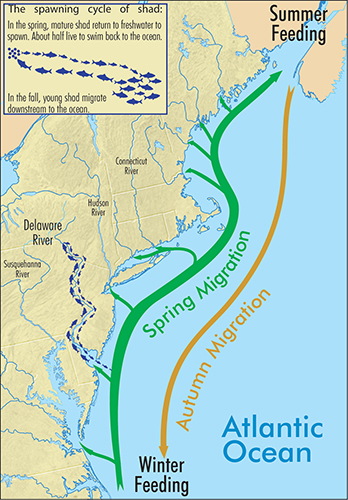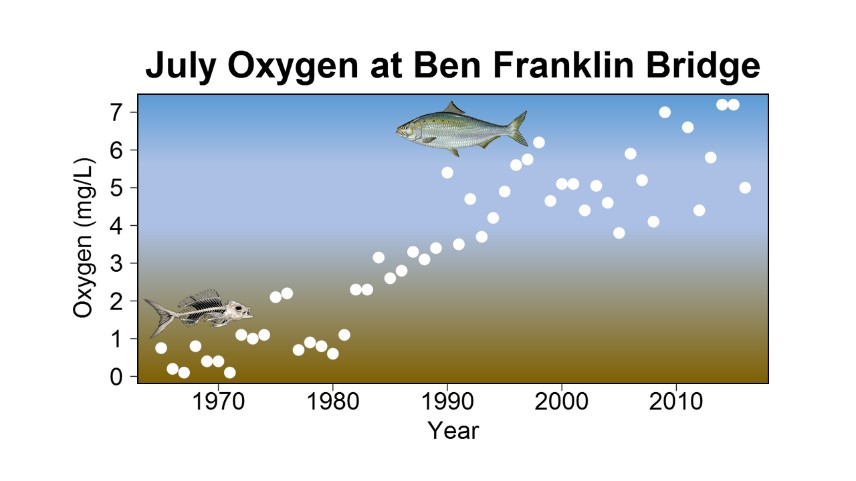Delaware • New Jersey • Pennsylvania
New York • United States of America
- American Shad Life Cycle
- Feast or Famine?
- Water Quality & Shad: Problems & Improvements
- Current Shad Numbers
- Festivals & Fishing Contests
- Links to Learn More
 |
| Graphic of American shad spawning cycle by DRBC. View larger image (jpg) |
American shad, Alosa sapidissima, are the largest North American member of the herring family. Adults commonly reach four to eight pounds. They fill an important role in the food chain as predator and prey.
They are an anadromous fish, which means they are born in freshwater, like the Delaware River, live for several years in the ocean and return to the river in which they were born to spawn (lay their eggs).
Female shad are called roes; males bucks.
Shad Life Cycle
After hatching in the spring, the young shad (called "fry") grow rapidly, feeding on freshwater plankton and aquatic insects.
Decreasing water temperatures in the late summer and early fall trigger a mass migration downriver to the ocean.
Once in the ocean, where they live most of their lives, shad will migrate up and down the coast, from their winter range off the mid-Atlantic to their summer range in the Bay of Fundy, off Nova Scotia.
After three-to-five years at sea, American shad will return in the spring to the river of their birth to spawn. They feed heavily prior to spawning and do not eat during their trip "home."
The Delaware River is an important waterway for American shad. The fact that there are no dams on the mainstem Delaware greatly increases the American shad's success at traveling upriver to spawn.
Unlike Pacific salmon, not all shad die after spawning. However, it is believed that half or more perish in the Delaware because the spawning run is a long, difficult journey and high energy is exerted. Shad that survive will swim downstream very soon after spawning (these shad are referred to as "downrunners").
Did You Know?
An American shad may migrate 12,000 or more miles during an average life span!
 |
| An American Shad. Photo by DRBC. |
Beyond filling an important role in the food chain as both predator and prey, American shad also served as a food source for people.
Often referred to as the "Poor Man’s Salmon," the full-flavored meat of the shad is reflected in its Latin name, sapidissima, meaning "most savory."
Shad roe, or eggs from the female, are considered a delicacy.
Shad & the Revolutionary War
Some say George Washington and his troops feasted on shad caught from the Schuylkill River (the Delaware's largest tributary) in the spring of 1778 following their bitter winter encampment at Valley Forge. They credit an early spring run of American shad that year with helping to save the Continental Army from starvation.
However, in his 2002 book about the American shad, The Founding Fish, author John McPhee disputes this account. He writes,
With respect to George Washington, it would not have been a leap of imagination for him to anticipate the spring shad run and choose a campsite accordingly. He was a commercial shad fisherman. Moreover, he did not require Daniel Boone to tell him that the Schuylkill was a prime fishery. While another river might be half a mile wide, this one was small enough to string a net across and by 1777 had long been synonymous with shad.
McPhee concludes,
The famine of Valley Forge, in 1778, was not alleviated by 1777 shad arriving in barrels. Nor, in fact, did it end as a result of the 1778 spring migration . . . The emotive account of the nation-saving shad is a tale recommended by everything but sources.
19th Century: Peak Shad Runs
While the shad may not have saved Washington's troops, McPhee did say "the American shad related to Philadelphia as the cod did to Boston."
In fact, by the late 1890s, the Delaware River had the largest annual commercial shad harvest of any river on the Atlantic Coast.
 |
| Dissolved Oxygen Levels in the Delaware River. |
20th Century Problems
In the 1900s, factors such as overfishing, dammed spawning tributaries and degraded water quality (e.g. low dissolved oxygen) all contributed to population decline.
By the height of World War II, the tidal Delaware River, including the urbanized section around Philadelphia/Camden/Wilmington, was an open sewer.
Along some reaches, the pollution robbed the river of all its oxygen, making it impossible for American shad and other fish to breathe.
This "pollution block" made it difficult, and at times, impossible, for shad to complete their migration cycles.
Adult shad that were ready to return to their birth rivers to reproduce could not travel through these heavily polluted waters.
The Lewis fishery in Lambertville, New Jersey caught 10,000 shad in 1896.
By 1953, the total catch was zero.
The Return of the Shad
The DRBC was formed in 1961 and soon got to work developing water quality criteria and regulations to control pollution and improve dissolved oxygen levels in the Delaware Estuary.
The creation of the U.S. EPA and the passage of the Clean Water Act in the 1970s further helped bring the river back to life, through investments in wastewater treatment and additional regulation.
By the 1980s and 1990s, significant improvements in the Delaware River's water quality were realized. Its cleanup is hailed as one of the world's top water qulaity success stories.
With improved dissolved oxygen in the water to support resident and migratory fish, the shad - and other species - returned to the river.
Low Shad Stock
American shad are managed by the Atlantic States Marine Fisheries Commission (ASMFC) under a fisheries management plan implemented to facilitate cooperative management and stock restoration among the states.
In recent years, American shad numbers have slipped in nearly all river systems along the Atlantic coast, including the Delaware.
Declines are possibly due to ocean-intercept fisheries, excessive predation by game fish such as striped bass and various other threats to habitat in rivers, estuaries and the Atlantic Ocean where shad spend most of their adult lives.
Because of the reduction in shad stocks, the ASMFC passed an amendment to their fishery management plan for American shad that says that unless a waterway has an ASMFC-approved sustainable management plan, recreational and commercial harvest of American shad is prohibited.
Managing American Shad
Members of the Delaware River Basin Fish and Wildlife Management Cooperative (Co-Op), of which DRBC is a liaison member, developed a sustainability plan for American shad for the Delaware River (pdf) in March 2022.
The sustainability plan set benchmarks that must be met for the fishery to remain open. Monitoring and data analysis by Co-Op members and partners ensure that the plan's benchmarks are being met.
In 2023, recreational daily possession limits specifically for American shad were reduced to two fish per day on the Delaware River (was three per day).
The 33% reduction in the shad harvest for both the commercial and recreational shad fisheries implemented in 2023 helped the population remain stable according to biologists. Therefore, in 2024, the limit will remain at two fish per day for the Delaware River.
The Co-Op also contracted with The Nature Conservancy (TNC) to produce the American Shad Habitat Plan for the Delaware River (pdf; 2021). This plan was submitted to the ASMFC to meet their requirement that all states submit a Habitat Plan for American Shad stocks in their jurisdiction.
- TNC also created a story map: Tipping the Scales - Restoring American Shad in the Delaware River Basin
Efforts to Monitor American Shad on the Delaware River
- The Lewis Fishery haul seine operation in Lambertville, N.J. measures the spring spawning run
- The Pa. Fish and Boat Commission's gill net survey at Smithfield Beach in the Delaware Water Gap National Recreation Area also measures the spring spawning run
- The Co-Op and its partners survey the young-of-year shad as they travel downriver in the fall to the estuary and ocean. Learn more: DRBC Participate in Effort to Monitor Juvenile American Shad in 2017 and DRBC Staff Helps with 2021 American Shad Young-of-Year Data Collection
Continued management, monitoring and research efforts play a key role in ensuring the Basin's shad population remains healthy.
 |
| An American shad caught by the Lewis Family at the Lambertville Shad Festival. Photo by DRBC. |
Water quality improvements and the return of the American shad to the Delaware River in the 1980s were cause for celebration.
Communities, including Lambertville, N.J., Easton, Pa., Wilmington, Del. and even those along the upper Delaware River, have started holding annual festivals and fishing contests in the spring to celebrate the shad's return to their local waters.
Lambertville Shad Festival
• Lambertville, N.J. Shad Festival
Lambertville's Shad Festival was originally organized in 1981 to celebrate cleaner water and the return of the shad. This annual festival, in its 40th year in 2021, also highlights the region's arts community and the City of Lambertville, turning the downtown into a street fair, complete with crafts, music, food, and camaraderie.
But, for most, the focus of the Shad Festival is still the shad.
Lambertville's Lewis Fishery is the last N.J. commercial shad fishery on the non-tidal river. William Lewis established the fishery in 1888; his son Fred Lewis took over the family business. Upon Fred's passing in 2004, grandson Steve Meserve took the helm and carries on the family tradition to this day.
The fishery operates off of a small island in Lambertville that bears its name. During Shad fest, folks travel down to the island along the river to watch the Lewis Fishery traditionally fish for shad (seine) using nets.
Check out this video for a great aerial view of the Lewis Fishery at work. Here's another, courtesy of the William Penn Foundation: https://vimeo.com/767938904.
Steve Meserve and the Lewis Fishery were featured in this October 2022 Yale360 article: https://e360.yale.edu/features/delaware-river-clean-water-act.
Steve Meserve and the Lewis Fishery also were featured on the Travel Channel's "Bizarre Foods with Andrew Zimmern."
DRBC has participated in the Shad Festival for decades. The Lewis Family welcomes us onto the island, where we set up to talk about the Delaware River Basin and do water quality demos.
Bi-State Shad Fishing Contest
- Bi-State Shad Fishing Contest (Easton, Pa. and Phillipsburg, N.J.)
American shad are a popular sport fish, with a reputation of being among the strongest and hardest-fighting of all fish found in freshwater.
People still look forward to spring when the shad return to the Delaware River, up for the challenge of hooking one as it travels upstream to spawn.
The Bi-State Shad Fishing Contest is a 4-day competition each April on the Delaware River around Easton and Phillipsburg.
Other Shad Festivals
- Brandywine Shad Festival
- Festival of the Founding Fish: Upper Delaware ShadFest (Inaugural event in 2022)
Fishing Groups
State Agency Information
- Atlantic States Marine Fisheries Commission: Shad and River Herring
- New Jersey Fish and Wildlife: American Shad
- New York State Department of Environmental Conservation
- Pennsylvania Fish and Boat Commission
- Biologist Reports Zone 5 (Northeast PA)
- Biologist Reports Zone 6 (Southeast PA)
- Biologist Reports Zone 5 (Northeast PA)
Federal Agengy Information
Other
- DRBC's Shad Flyer (pdf)
- University of Delaware Water Resource Center: Brandywine Shad 2020
- Pennsylvania's Delaware River Shad (Pennsylvania Game & Fish Magazine)
- "The Founding Fish," by John McPhee
- Fishtown and the Shad Fisheries (The Historical Society of Pennsylvania)
- American Shad Timeline Along the Delaware River
Copyright © Delaware River Basin Commission,
P.O. Box 7360, West Trenton, NJ 08628-0360
Phone (609)883-9500; Fax (609)883-9522
Thanks to NJ for hosting the DRBC website